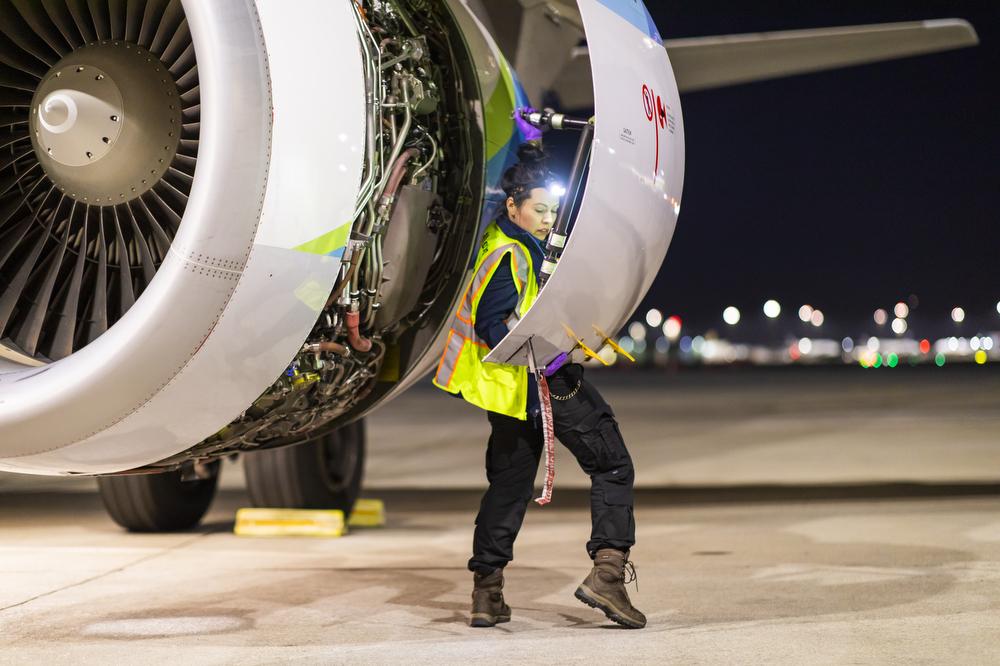
A study being conducted by members of the FAA’s Women in Aviation Advisory Board has found that gender balance issues within the industry may be driving a significant number of women away from aviation careers.
During a panel on building an inclusive workforce at MRO Americas in Orlando, Florida, preliminary results of the Liftoff to Leadership study were shared that shed some light on factors driving women away from the workforce. The research, which is being conducted by consulting firm Oliver Wyman and the International Aviation Womens Association (IAWA), found that approximately 31% of the more than 300 women surveyed have considered leaving the aviation industry due to gender-related challenges such as bias discrimination, lack of professional opportunities and inflexibility around working hours.
According to Oksana Bardygula, vice president of Oliver Wyman CAVOK, the study has found that early positive experiences—such as being valued for contributions or being acknowledged when speaking—support people as they continue to move into leadership positions. “On average, women are experiencing 10% fewer positive experiences beginning in and throughout their careers than men,” says Bardygula. “On the flip side, especially in the center leadership positions, we’re seeing that women are experiencing about 30% more negative experiences.” These, she says, include things like lack of opportunities or being passed up for an opportunity.
While women are being pushed out of the industry due to negative experiences, Bardygula says the study has shown that when men leave aviation, they are actually being pulled out because of greater opportunities or higher pay. Unfortunately, she notes, opportunities for women are also being hampered due to what the study calls “The Mom Factor.”
“The progression for women in our industry is pretty narrow, and unfortunately it’s even more narrow for women who have children,” she says. “For those women, things like flexibility and sponsorship are really important. Our study showed that you are more likely to reach a C-level position as a female if you do not have children.”
Although the study found that sponsorship—which entails a person advocating on behalf of someone else when they are not in the room—is very important for women, 65% of the women surveyed said they had never had a sponsor in their career.
According to Bobbi Wells, vice president of safety and airworthiness, air operations at FedEx Express, these factors affect womens’ confidence in achieving career progression. “Men and women reported in equal measure their belief that they can be successful at higher levels and their confidence that they have the right skills and capabilities to be successful at those higher levels, but men significantly outpaced women when it came to reporting whether they thought they would get promoted to those levels,” says Wells. The study found that 30% more men reported an expectation they would reach higher levels than the women surveyed.
Confidence was not the only area where thinking differed between men and women. The study found that women and men have different prioritizations on what is important when it comes to corporate programs devoted to gender diversity. Men highly prioritized factors such as clear communication and penalties for harassment and women did not, whereas women highly prioritized factors such as flexibility and men did not.
Bardygula notes that men were more likely to think gender balance was being achieved due to policies and procedures that were in place at organizations, but that women reported they did not think this was true. “Having a policy doesn’t mean that it changes the culture—it just means that you have a policy,” she says, adding that it is important to bring women in when creating gender diversity and inclusion programs. “The reality is that it is very hard to both identify and solve a problem that you yourself have not experienced.”
According to Bardygula, companies can also tackle the issue by giving more visibility to women, including assigning them projects that have high visibility or making sure there is at least one woman on every conference panel. “That allows other women who are coming into the industry to see representation, it gives them encouragement and it helps them identify the people they can connect with to create their own form of mentorship,” she says.
Wells also encourages people in the industry to sponsor a person from a background that differs from their own and says companies should establish and encourage women’s networks. “Oftentimes when women are alone in the room, and especially when they’re young, they feel like what they’re going through is only their experience,” says Wells. “They don’t think anyone else struggles in the same way that they do, and that’s just not reality.”
Preliminary results of the Liftoff to Leadership study will be released sometime near the end of May or beginning of June 2021. The main goal of the Women in Aviation Advisory Board, which was established in 2020 as part of the FAA Reauthorization Bill, is to bring recommendations to Congress and the FAA about how to improve gender balance in aviation.





